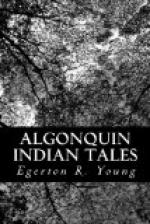“That there was such a thing as fire was well known. It had been seen bursting out of the tops of distant mountains, and there had been times in great thunderstorms, when the lightning had set fire to dead trees—and indeed in this latter way the Indians had become acquainted with its value to the human race. But they had not taken care to keep it burning, and no one had been appointed to specially look after it.
“The reason why fire had not been from the first given to men was because when the race was created the fire was not much needed. The earth was then much warmer than it is now. There was no snow or ice ever seen except on the tops of the very highest mountains. Great animals now all dead, and others that could only live in the hottest countries, lived all over these great lands. Then there was abundance of fruit and nuts and roots that were all very good for food. Then some great disaster happened to the world and soon it began to grow colder and many animals, and even families, perished. Snow and ice appeared where they were never seen before. There was great suffering from the cold. The hunters began to kill the animals for food. They were now not satisfied with the fruit and roots, they wanted something better.
“So the fire was much needed. But where it was, or how to get it, was the question. Fortunately an old dreamer dreamed a dream about it. As the council assembled to hear his dream he told them that the fire was preserved in the heart of the earth by a magician called Sistinakoo, and that it was kept very carefully surrounded by four walls, one within the other, in each of which was a single door. At the first door a great snake kept guard. At the second door a mountain lion or panther was the guardian. A grizzly bear guarded the third door, and at the fourth and last door Sistinakoo himself kept watchful care over the precious fire that smoldered on a stone altar just inside this last wall.
“When the council heard all this they were almost discouraged. They thought it would be impossible for anyone to get by all of these guards and steal the fire.
“They first asked the fox to try, but he only reached the first door when the great snake nearly made a meal of him. Thoroughly frightened, he rushed back to the top of the earth and told of his narrow escape.
“For a time nothing more was done to try and get the fire. The people continued to suffer, for the earth kept getting colder and colder and ice and snow were now to be found in lands that had previously been comfortably warm. So the council was called again, and the question again raised as to what could be done.
“It happened that there came to the council a very old man who remembered a tradition, handed down from his forefathers, which said that part of the earth beneath us was hollow, and that some of the animals, even the great buffaloes, had dwelt in those underground regions before they came to dwell on the surface of the earth. He said that the coyote, the prairie wolf, was the last one to leave, and that he was sure that he still remembered the route to the very spot where Sistinakoo, the head chief of the regions, guarded the fire so jealously.”




